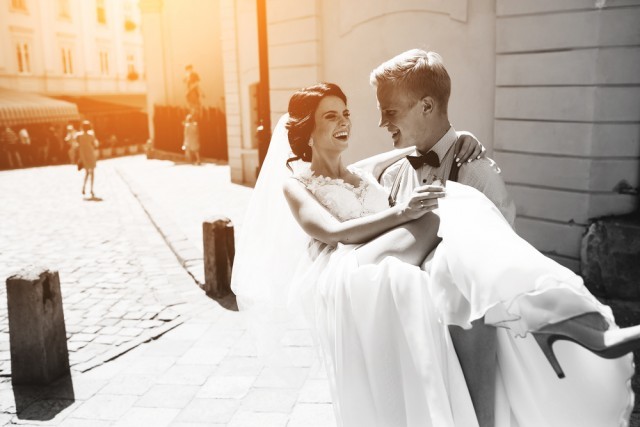Do you ever wonder where popular wedding practices come from? If you’re planning a wedding or helping someone plan their big day, you might be interested to learn that most modern traditions are derived from ancient customs and superstitions—some of which are rather creepy and unromantic.
These days, couples are choosing to alter or skip some customs altogether. Here are five contemporary traditions, where they came from, and how they’ve changed over the years:
1. Something old, something new, something borrowed, and something blue.
Popular belief says a bride should wear each of these items during her wedding ceremony to ensure a happy marriage. Experts say the saying comes from an English rhyme about the necessary good luck charms for a wedding. Something Old represents a bride’s connection to her family. Something New represents a bride’s life that will come after marrying her husband. Something Borrowed should be a token of good luck passed on from someone who has had a successful marriage. Something Blue represents the loyalty and faithfulness of the new couple.
Modern twist: Today, many DIY brides opt to work these elements into their wardrobe choices. A bride might wear blue shoes or incorporate an old piece of lace into her new dress. There are no rules, and brides can choose to follow this tradition or omit it altogether.
2. Taking a walk down the aisle.
This tradition originated long ago, when arranged marriages were prominent. During this time, a bride’s family would choose her husband and she might not even know him. The tradition of walking her down the aisle stemmed from a father’s need to physically give his daughter’s hand in marriage away to the man—a symbolic passing of property, if you will.
Modern twist: These days, this journey down the aisle is more symbolic than anything. And in recent years, other methods of travel have emerged, like choreographed dance, the bride and groom leading guests in a processional behind them, or just starting the ceremony at the altar. It is tradition for a bride to be escorted by her father, but sometimes both parents or another family member gets involved. Other times, a bride will walk unaccompanied. Grooms also have a variety of options for getting to the altar, as some walk with family members or enter the ceremony at the altar. During same-sex ceremonies, couples often walk down the aisle together—there’s really no wrong answer!
3. A bride wearing a veil during the ceremony.
This is a tradition that hails from Ancient Rome. Legend says a bride should be covered head to toe on her wedding day by heavy veils in order to ward off evil spirits and malicious intents. A long veil and train also helped to ensure the bride wouldn’t run away from her soon-to-be husband—who she might not have met yet.
Modern twist: While many brides do still wear veils, they are not as overwhelming as the traditional veils of the past. These days, veils are long and delicate, and sometimes, they don’t even cover a woman’s face. Some brides opt to skip a veil altogether and instead wear flowers, crowns, wreaths, or headpieces in its place.
4. Wearing your wedding ring on that finger.
Why do newlyweds (and engaged people) wear their rings on the left hand? This is another tradition that stems from the Ancient Romans. According to legend, they believed that there was a vein in the left ring finger that led directly to the heart—a so-called “love vein.” So, in order to represent their union with their spouse, they would wear a ring on that finger.
Modern twist: These days, it’s really up to couple to determine how they wear their rings. Some couples opt for the right hand, while others decide to forgo the rings altogether and get tattoos on that finger. It’s a matter of preference!
5. The groom carries his bride over the threshold.
Have you ever seen a movie where the groom carries his bride into the house? There’s a reason for this! According to the legend that one source found, a bride is susceptible to the evil spirits that are said to linger at the doorway of a home and can enter through the soles of her feet. By carrying her into the home for the first time, the groom protects his bride from any bad luck or ill will that could impact their marriage.
Modern twist: While there are several reasons a groom might carry his bride into the home, today it’s really just something couples do for fun. Some couples omit it altogether, while others piggyback across the doorway. Most commonly, we see it in romantic comedies!
Interested in wedding planning and want to learn more about earning your bachelor’s degree in Sports, Entertainment, Event — Management? Complete the “Request Info” form on this page or call 855-JWU-1881.
